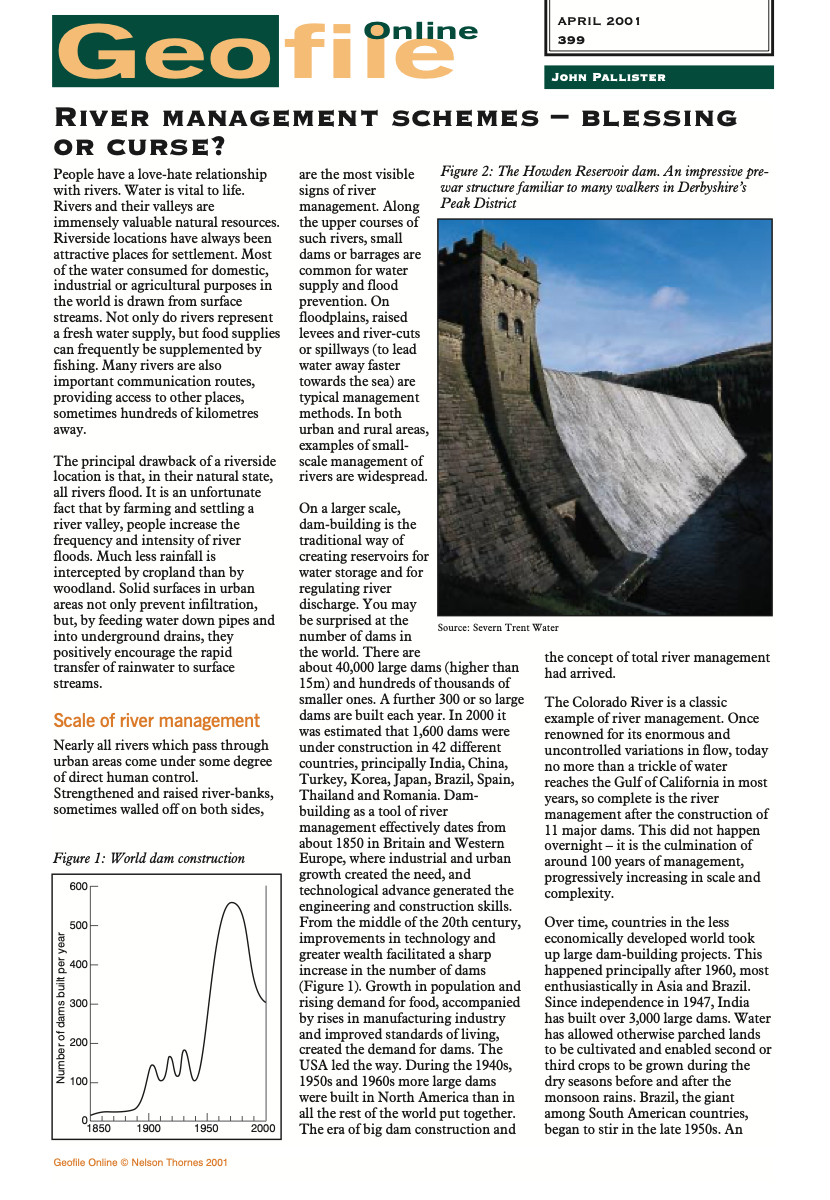IB

|Freshwater Lesson's |
|Recontextualisation|
|Recontextualisation is a process that extracts text, signs or meaning from its original context and reuses it in another context.|
|1. What is a drainage basin? |

|2. How does a drainage basin function(inputs/processes/ storages and outputs)? |
|3. Can I explain what a systyem is and what the difference is between an open and a closed system?|
|1. What typical landforms might be found within a basin?|
|2. Can I explain(using AO4 diagrams and text )how the named landforms are formed?|
|1. What is River Discharge and how is it measured?|
|2. What is the difference between stream flow and discharge?|
|3. What is hydraulic radius and how is it measured?|
|1. What different types of erosion are there and how do they affect the River?(HAAS)|
|2. What different types of transportation(TSSS) are there and how do they affect the River?|
|3. What and why does deposition occur?|
|Ensure to be able to talk about how these change in regards to space, place and what factors might influence these processes.
|Content|
|1. Drainage basin hydrology and geomorphology|
The drainage basin as an open system with inputs (precipitation of varying type and intensity), outputs (evaporation and transpiration), flows (infiltration, throughflow, overland flow and base flow) and stores (including vegetation, soil, aquifers and the cryosphere) River discharge and its relationship to stream flow, channel characteristics and hydraulic radius River processes of erosion, transportation and deposition and spatial and temporal factors influencing their operation, including channel characteristics and seasonality The formation of typical river landforms, including waterfalls, floodplains, meanders, levees and deltas
|Lesson|
|Lesson 1|
|Lesson 2 |
|Lesson 3|
 |  |
|---|---|
 |  |
 |
|Lesson 4|
|Lesson 5|
|Reading/Revision & Assessment|
|A01 Language|
Hydrology - the branch of science concerned with the properties of the earth's water, and especially its movement in relation to land.
Geomorphology - is the study of landforms, their processes, form and sediments at the surface of the Earth (and sometimes on other planets). Study includes looking at landscapes to work out how the earth surface processes, such as air, water and ice, can mould the landscape.
|Media|
CLICK ON ME
Time for Geography brings together a unique community of geographers, film-makers and educators, with experience from across the spectrum of geography. We work together to produce the best possible educational content, supported through partnerships with universities and organisations who share our vision. The mission of Time for Geography is further supported through contributions and engagement with our user-community of geographers, and by councils and land owners who enable us to film in geographically important locations across the world.
|2. Flooding and flood mitigation|
|Lesson|
 |  |
|---|---|
 |  |
 |  |

Hydrograph characteristics (lag time, peak discharge, base flow) and natural influences on hydrographs, including geology and seasonality How urbanization, deforestation and channel modifications affect flood risk within a drainage basin, including its distribution, frequency and magnitude Attempts at flood prediction, including changes in weather forecasting and uncertainty in climate modelling Flood mitigation, including structural measures (dams, afforestation, channel modification and levee strengthening) and planning (personal insurance and flood preparation, and flood warning technology)
• Two contrasting detailed examples of flood mitigation of drainage basins
|Lesson 6|
|Lesson 5|
|Lesson 5|
|Lesson 6|
|Lesson 7|
|Lesson 8|
|Reading/Revision & Assessment|
|Questionbank Rivers|
CLICK ON ME!
Tip:Ensure to go through the questionbank and practice some of the quetions.

Lesson 4: Reading p.72
|Fantastic Example of a Picture Essay|
READING (GUARDIAN) : 'Death toll mounts in Italy’s worst flooding for 100 years
China landslide death toll rises to 31 after dozens buried in freezing winter temperatures
|Media in the classroom|
READING (BBC) COP27: 'We'd never seen this much water' - Pakistan flood survivors
Pakistan Floods 2010
Climate Modelling
Germany Floods 2021
Why Engineers Can't Control Rivers
|3. Water scarcity and water quality|
Physical and economic water scarcity, and the factors that control these including the causes and impacts of droughts; the distinction between water quantity and water quality Environmental consequences of agricultural activities on water quality, to include pollution (eutrophication) and irrigation (salinization)
• Detailed examples to illustrate the role of different stakeholders Growing human pressures on lakes and aquifers, including economic growth and population migration Internationally shared water resources as a source of conflict
• Case study of one internationally shared water resource and the role of different stakeholders in attempting to find a resolution
|Lesson|
|Lesson 9|
|Lesson 10|
|Lesson 11|
 |  |
|---|---|
 |
|Reading/Revision & Assessment|

|Media in the classroom|
US states agree breakthrough deal to prevent Colorado River from drying up
|The Colorado River: A Photo Essay|
|Colorado Case Study|
|Colorado Case Study|
|Water Quality|
|Colorado Case Study|
|4. Water management futures|
|Lesson|
The importance of strengthening participation of local communities to improve water management in different economic development contexts, including sustainable water use and efficiency, and ensuring access to clean, safe and affordable water Increased dam building for multipurpose water schemes, and their costs and benefits
• Case study of contemporary dam building expansion in one major drainage basin The growing importance of integrated drainage basin management (IDBM) plans, and the costs and benefits they bring
• Case study of one recent IDBM plan Growing pressures on major wetlands and efforts to protect them, such as the Ramsar Convention
• Case study of the future possibilities for one wetland area
|Lesson 12|
|Lesson 13|
|Lesson 14|
|Lesson 15|
|Lesson 16|
 |  |
|---|---|
 |  |
 |  |
 |
|Lesson 17|
|Lesson 18|
|Reading/Revision & Assessment|
Tip:China's Three Gorges Dam is one of the largest ever created. Was it worth it?

|Lesson 16|
|Lesson 18|
|Media in the Classroom|
|IB Geography: Integrated drainage basin management plans, costs and benefits|
|Bhutan's First Integrated River Basin Management Plan|
Tipping Point: The Colorado River Basin
|Case Study Cards|
|Revision Notes|
|Essays|
|Exam papers|Revision|





















































